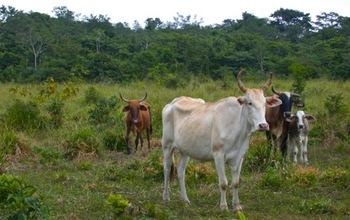Natural regeneration of tropical forests helps global climate mitigation and forest restoration

Pasture with young second-growth forest in the background in Chiapas, Mexico. Credit: Robin Chazdo
Climate scientists have long recognized the importance of forest conservation and forest regrowth in climate mitigation and carbon sequestration — capturing carbon dioxide (CO2) from the atmosphere. But the detailed information required to make accurate estimates of this potential has remained elusive.
Now, an international team of 60 scientists, working together as the 2ndFOR Network, has completed studies on the effects of forest conservation and secondary forest regeneration across 43 regions in Latin America.
In an article titled “Carbon sequestration potential of second-growth forest regeneration in the Latin American tropics,” published today in the journal Science Advances, University of Connecticut ecologist and evolutionary biologist Robin Chazdon and her colleagues report a series of new findings.
Long-term studies
“This study uses knowledge gained from long-term studies of tropical forests to address a pressing societal need,” says Saran Twombly, program director in the National Science Foundation (NSF) Division of Environmental Biology, which funded the research through NSF's Long Term Research in Environmental Biology, and Dynamics of Coupled Natural and Human Systems, programs. “It shows that natural processes can provide a solution to the excess carbon dioxide threatening the planet.”
The studies aimed to model the areas covered by regrowth forests across the lowlands of the Latin American Tropics in two age classes; to project potential above-ground carbon storage in these young forests over four decades; and to illustrate alternative scenarios for carbon storage where 0-80 percent of these forests are allowed to regenerate.
Chazdon says that “this research is vital because actively growing vegetation takes carbon dioxide out of the atmosphere and converts it to plant tissues such as wood and leaves. Old-growth forests contain large stocks of carbon in their biomass. When these forests are cleared and burned, this carbon is released into the atmosphere, contributing to global warming. This is one of the main reasons why it is important to halt deforestation.”
But scientists have also learned that when forests regrow, their carbon stocks in above-ground biomass increase over time, depending on climate, prior land use and features of the surrounding landscape.
“This regrowth can happen without planting trees, through the spontaneous process of natural regeneration,” says Chazdon. “This is a low-cost way of restoring forests and of reaching carbon mitigation goals.”
Major findings
Among the major findings of the study are:
- Models of forest age in 2008 show that 17 percent of the forest area in lowland Latin America consists of young second-growth forest (1-20 years) and 11 percent consists of intermediate age forest (20-60 years).
- Assuming that 100 percent of the second growth persists and regenerates over 40 years, carbon storage capacity doubles in young second growth and increases by 120 percent in intermediate age forests. In both forest age classes, a net gain of 8.48 trillion kilograms of carbon is stored over 40 years.
- amount is equivalent to 31.09 trillion kilograms of CO2, which equals all the carbon emissions from fossil fuel use and other industrial processes in all the countries of Latin America and the Caribbean from 1993 to 2014.
- Ten countries account for 95 percent of this carbon storage potential, led by Brazil, Colombia, Venezuela and Mexico.
Forest-based climate change solutions
Chazdon says that, remarkably, this huge amount of carbon storage doesn't require costly tree plantings or conversion of farmlands. “It is all based on natural forest regrowth and only requires persistence and protection of the young forests and abandoned agricultural fields.”
Forest-based solutions provide many other benefits, including hydrologic regulation, habitats and corridors for conserving biodiversity, and provision of non-timber forest products to local people, Chazdon says.
Prior carbon storage efforts have placed emphasis on avoiding deforestation. But, Chazdon says, “avoiding deforestation and supporting forest regeneration are complementary and mutually reinforcing activities.”
While forest regeneration and protection alone cannot fully compensate for greenhouse gas emissions on a global scale, researchers say the study affirms that this strategy can contribute significantly toward reaching national and international carbon mitigation targets.
Media Contact
All latest news from the category: Earth Sciences
Earth Sciences (also referred to as Geosciences), which deals with basic issues surrounding our planet, plays a vital role in the area of energy and raw materials supply.
Earth Sciences comprises subjects such as geology, geography, geological informatics, paleontology, mineralogy, petrography, crystallography, geophysics, geodesy, glaciology, cartography, photogrammetry, meteorology and seismology, early-warning systems, earthquake research and polar research.
Newest articles

NASA: Mystery of life’s handedness deepens
The mystery of why life uses molecules with specific orientations has deepened with a NASA-funded discovery that RNA — a key molecule thought to have potentially held the instructions for…

What are the effects of historic lithium mining on water quality?
Study reveals low levels of common contaminants but high levels of other elements in waters associated with an abandoned lithium mine. Lithium ore and mining waste from a historic lithium…

Quantum-inspired design boosts efficiency of heat-to-electricity conversion
Rice engineers take unconventional route to improving thermophotovoltaic systems. Researchers at Rice University have found a new way to improve a key element of thermophotovoltaic (TPV) systems, which convert heat…



